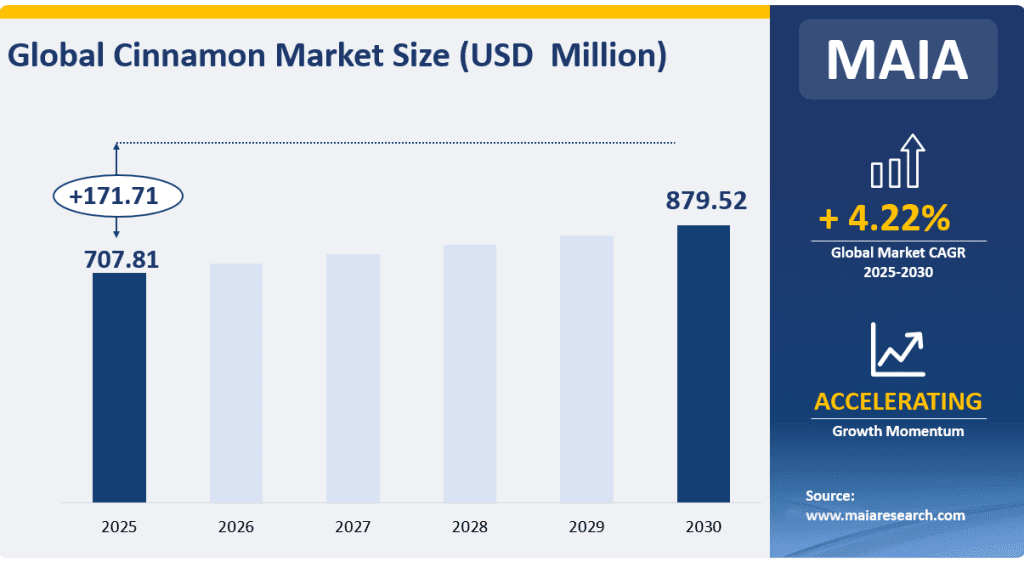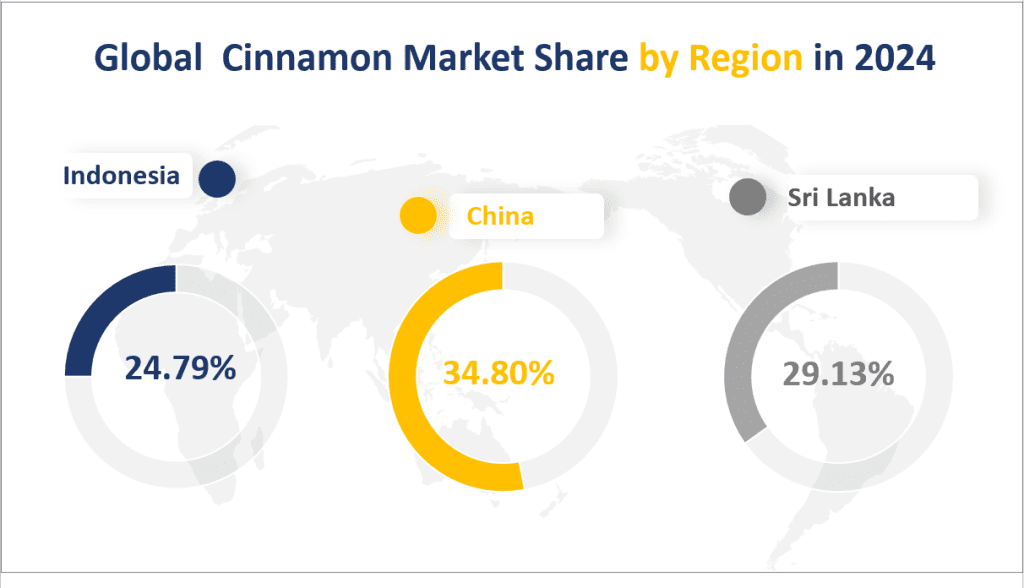1.Global Cinnamon Market Summary
According to Maia Research, the global Cinnamon is expected to grow to $707.81 million by 2025 with a CAGR of 4.22% from 2025 to 2030.
The Government of Sri Lanka has established the Ministry of Cinnamon Development to promote the cultivation, production, and export of cinnamon in July 2024. The government announced that the new department aims to assist cinnamon producers, suppliers, and exporters while improving the quality and variety of cinnamon products through added value.
Cinnamon is a medium-large tree of the Lauraceae family. Cinnamon bark is often used as a spice, cooking material, and medicinal material. The wood can be used to make furniture. This species can also be used as a landscaping tree. Cinnamon is native to China and is also found in India, Laos, Vietnam, and Indonesia. A warm and wet climate is fit for its growth, but too much rain will cause rotten leaves. Seedlings need to grow in shade and mature trees grow normally in more sunlight. Deep, loose texture, good drainage, permeability strong slightly acidic, or acidic sandy loam or loam is preferred.
Global Cinnamon Market Size

2.Market Dynamics
Opportunities
Mixed spices emerged as a new beneficial combination, providing food with multiple flavors. Currently, food manufacturers create innovative mixtures by adding different spices. These mixed spices are further used for flavoring and other purposes. Spices (such as cinnamon, turmeric, black pepper, ginger, and chili) are widely used because of their flavor mixing. As consumers around the world desire vibrant spices and flavor characteristics, flavor manufacturers are developing innovative solutions by providing blended flavors. In addition, mixed spices also have many health benefits, such as antioxidants and anti-inflammatory effects.
Customers are increasingly inclined to buy cinnamon products online, which is considered to be one of the important trends affecting market growth. Due to factors such as shopping convenience and competitive prices, some customers are increasingly turning to online shopping for cinnamon products. In addition, suppliers in the cinnamon industry provide customers with various cinnamon and related products which are mainly provided to consumers through company websites and other e-commerce platforms. The development of e-commerce is expected to have a positive impact on market growth
The “organic” trend has influenced consumers to add more organic food to their diet. This trend has also affected cinnamon producers. In addition, food manufacturers are increasingly targeting health-conscious consumers and require their suppliers to provide organic cinnamon which further increases the cultivation and utilization of organic cinnamon. Organic cinnamon is grown under different circumstances, without the use of any pesticides.
Limitations
The promotion of global environmental protection awareness and the strengthening of food safety regulations have put forward higher requirements for the cinnamon industry. The refinement of environmental regulations and the improvement of resource utilization efficiency require the cinnamon industry to promote the green and low-carbon transformation of the production process. The transformation and upgrading of the cinnamon industry is an inevitable trend, and the innovation of processing technology and the promotion of intelligent production are the core driving forces for the development of the industry. Traditional cinnamon processing relies on manual operation, low efficiency and product quality is difficult to be stable, and technological innovation is needed to improve efficiency and product quality. The cinnamon industry is highly dependent on a sustainable supply of natural resources, but frequent extreme weather and unjustified deforestation caused by climate change threaten the growing environment of the cinnamon tree, increasing the volatility of the raw material supply. As consumers become more concerned about healthy eating and demand for organic, no-add cinnamon products increases, companies need to adapt to this market trend and actively develop and promote new products in line with the concept of health.
3.Market Segmentation
By Type
Cinnamon spice can be divided into Ceylon cinnamon and Cassia cinnamon. Cassia segment accounts for the largest share of 69.46% in 2024 with a market scale of $479.6 million.
Cassia is an aromatic bark, similar to cinnamon, but differing in strength and quality, and it has a strong aroma and flavor. It is widely used as a spice, especially in cookery as a condiment, and as flavoring material. The health benefits of cinnamon found in numerous studies are that it regulates blood sugar, making it a great choice for diabetics and hypoglycemics alike. It reduces LDL cholesterol levels. LDL is also known as the harmful cholesterol. Reducing it may help reduce the risk of cardiovascular disease. In the perfumery industry and the pharmaceutical industry Ceylon cinnamon is a potential natural treatment for diabetes. It also has anti-inflammatory, antioxidant, and antimicrobial that support the immune system.
By Application
In terms of application, it is mainly applied in household and commercial use. Commercial use is mainly in the food and beverage industry, cosmetics industry, medicine, and other industries. Household is mainly used as a flavoring agent for cooking or baking.
Table Cinnamon Market Segmentation
By Type | Market Size in 2024 | Market Share in 2024 | |
Ceylon | $479.6 million | 69.46% | |
Cassia | $206.8 million | 30.54% | |
By Application | Residential | $419.7 million | 60.86% |
Commercial | $266.7 million | 39.14% |
4.Regional Market
According to different origins, it can be further divided into Indonesian cinnamon, Chinese cinnamon, and Saigon cinnamon.
China is the largest revenue market with a market share of 34.80% in 2024 and a market value of $240.21 million in 2024. Sri Lanka ranks the second market with a market scale of $176.9 million in 2024. Also, Vietnam and Indonesia are important markets. Vietnam is also an important cinnamon producer, with its cinnamon exports accounting for about 34.4% of the global export market share in 2023.
China is one of the main producing countries of cinnamon, and Guangxi is the main producing area of cinnamon. The market demand for cinnamon in China is booming, and the development prospect of cinnamon in China is good. With consumers’ pursuit of food taste and product diversity, the cinnamon industry faces diversified market demand. With the increasing health awareness of consumers, the diversification of dietary preferences, the promotion of traditional medical applications, and the expansion of demand in the food and beverage industry, the global demand for cinnamon and cinnamon products is growing. China’s cinnamon exports are far greater than imports, Guangxi cinnamon exports accounted for about 70% of the country’s total exports of cinnamon, the main export direction for Vietnam, Bangladesh, Pakistan, India, and so on.
The world’s largest producer and exporter of pure cinnamon, Sri Lanka is a tropical island with year-round sunshine and agriculture is the most important sector of its economy. The EU supports the initiative of Sri Lanka’s newly established Ministry of Cinnamon Development through the Sri Lanka Export Agriculture Programme to promote Ceylon cinnamon exports to higher-value markets. Sri Lankan cinnamon is widely used in cooking, baking, and traditional medicine and is highly prized for its sweet and warm taste. In Sri Lanka, selected cinnamon entrepreneurs have been awarded a Geographical Indication (GI) certificate, and these distinctions recognize the highest standards of cinnamon cultivation and production, setting a benchmark for quality and excellence in the industry. Sri Lanka has established a newly formed Cinnamon Development Department dedicated to growing and increasing cinnamon production. The division aims to increase cinnamon production, leveraging advanced technology and support systems to upgrade the industry.
Regional Cinnamon Market Share

5.Market Competition
The global cinnamon industry concentrate rate is low. The top three companies are Rathna Ceylon Cinnamon, TRIPPER, and SDS SPICES (PVT) LTD with a revenue market share of 3.31%, 2.78%, and 2.37% in 2024.
Rathna Ceylon Cinnamon: Rathna Producers Cinnamon is the largest member of the Rathna group. RPCE is the largest and leading spice exporting company and extremely specializes in cinnamon which is native to Sri Lanka. RPCE has an excessively large customer base all over the world. The company holds the largest facility for cinnamon fully equipped and holds ISO22000-2005 and Lion logo for products. RPCE exports over 2000T along per year and its one-seventh of total country production. Currently employees over 500 direct workers and over 12000 indirect workers by RPCE.
TRIPPER: With over two decades of experience, Tripper is an industry leader in providing premium natural ingredients directly from origin. As a pioneer of organic and fair trade products in SE Asia, it produces to the highest of international standards. Tripper’s success in raw material control allows for the supply chain to be streamlined. Tripper brings quality spices straight from farmers and collectors directly to its facilities to be prepared for wholesale, commercial, and retail distribution.
SDS SPICES (PVT) LTD: SDS Spices grows and exports all spices unique to the isle of Sri Lanka. Founded in 2002 backed by the founder’s profound knowledge of spices, this fledgling company in a short period has grown rapidly to one of the largest exporters of Cinnamon in Sri Lanka.
Cassia Co-op: Cassia Co-op – a foreign/Indonesian-owned company – sources, processes, and markets cinnamon and patchouli oil. Currently, the company sources directly from over 2,200 farmers, thereby building a bridge between farmers and end users.
Q-SPICING: Q Spice S.A.E is one of Sofay Investment Group It’s one of the world’s largest companies specializing in the Middle East in the field of manufacturing, processing, sterilization, and packing Mediterranean Spice, Herbs, medical plants, dehydrated Onion, Dehydrated Garlic.
Table Market Major Players
Manufacturing Base | Market Share | |
Rathna Ceylon Cinnamon | Sri Lanka | 3.31% |
TRIPPER | Indonesia | 2.78% |
SDS SPICES (PVT) LTD | Sri Lanka | 2.37% |
Cassia Co-op | Indonesia | 2.27% |
Q-SPICING | Egypt | 1.84% |
Pdrexporters | Sri Lanka | 1.68% |
EOAS Organics | Sri Lanka | 1.62% |
Ceylon Spice Company | Sri Lanka | 1.43% |
Biofoods | Sri Lanka | 1.32% |
Phuc Sinh | Vietnam | 1.32% |
HDDES Group | Sri Lanka | 0.98% |
Rasdi & Co | Indonesia | 0.83% |
Latransa Citra | Indonesia | 0.65% |





